Investigation of Transport Processes through Ion-Exchange Membranes Used in the Production of Amines from Their Salts Using Bipolar Electrodialysis
Abstract
:1. Introduction
2. Materials and Methods
2.1. Objects of the Study
2.2. Investigation of Diffusion Permeability
2.3. Impedance Spectroscopy
2.4. IR Spectroscopy
2.5. Current-Voltage Characteristics of the Membrane
2.6. Investigation of Amines Production Processes in Laboratory Electrodialyzer
3. Results and Discussion
3.1. Investigation of Diffusion Permeability
3.2. Impedance Spectroscopy
3.3. IR Spectroscopy
3.4. Voltammetry
3.5. Investigation of Amine Production Processes in Laboratory Electrodialyzer
4. Conclusions
Author Contributions
Funding
Institutional Review Board Statement
Informed Consent Statement
Data Availability Statement
Conflicts of Interest
Abbreviations
| MA | methylamine |  |
| (MA)2H2SO4 | methylammonium sulfate | |
| DMA | dimethylamine |  |
| (DMA)2H2SO4 | dimethylammonium sulfate | |
| DEA | diethylamine |  |
| (DEA)2H2SO4 | diethylammonium sulfate | |
| EDA | ethylenediamine |  |
| EDAH2SO4 | ethylenediammonium sulfate |
References
- Shaposhnik, V.A.; Eliseeva, T.V. Barrier effect during the electrodialysis of ampholytes. J. Membr. Sci. 1999, 161, 223–228. [Google Scholar] [CrossRef]
- Eliseeva, T.V.; Shaposhnik, V.A. Effects of circulation and facilitated electromigration of amino acids in electrodialysis with ion-exchange membranes. Russ. J. Electrochem. 2000, 36, 64–67. [Google Scholar] [CrossRef]
- Shaposhnik, V.A.; Eliseeva, T.V.; Tekuchev, A.Y.; Lushchik, I.G. Assisted electromigration of bipolar ions through ion-selective membranes in glycine solutions. Russ. J. Electrochem. 2001, 37, 170–175. [Google Scholar] [CrossRef]
- Metayer, M.; Legras, M.; Grigorchouk, O.; Nikonenko, V.; Langevin, D.; Labbe, M.; Lebrun, L.; Shaposhnik, V. Facilitated transport of alanine and phenylalanine through sulfonic cation-exchange membranes. Desalination 2002, 147, 375–380. [Google Scholar] [CrossRef]
- Lightfoot, E.N.; Friedman, I. Ion Exchange Membrane Purification of Organic. J. Ind. Eng. Chem. 1954, 46, 1579. [Google Scholar] [CrossRef]
- Dohno, R.; Azum, T.; Takashima, S. Permeability of mono-carboxylate ions across an anion exchange membrane. Desalination 1975, 16, 55–64. [Google Scholar] [CrossRef]
- Sarapulova, V.; Nevakshenova, E.; Pismenskaya, N.; Dammak, L.; Nikonenko, V. Unusual concentration dependence of ion exchange membrane conductivity in ampholyte-containing solutions. effect of ampholyte nature. J. Membr. Sci. 2015, 479, 28–38. [Google Scholar] [CrossRef]
- Melnikov, S.; Kolot, D.; Nosova, E.; Zabolotskiy, V. Peculiarities of transport structural parameters of ion-exchange membranes in solutions containing anions of carboxylic acids. J. Membr. Sci. 2018, 557, 1–12. [Google Scholar] [CrossRef]
- Chandra, A.; Bhuvanesh, E.; Chattopadhyay, S. Physicochemical interactions of organic acids influencing microstructure and permselectivity of anion exchange membrane. Colloids Surf. A Physicochem. Eng. Asp. 2019, 560, 260–269. [Google Scholar] [CrossRef]
- Mazunin, S.A.; Chechulin, V.L. Applied aspects of use of amines for the production of inorganic salts in systems with salting-out. Russ. J. Appl. Chem. 2010, 83, 1690–1697. [Google Scholar] [CrossRef]
- Mazunin, S.A.; Chechulin, V.L.; Frolova, S.A.; Kistanova, N.S. Technology of obtaining of potassium dihydrophosphate in the system with salting-out. Russ. J. Appl. Chem. 2010, 83, 553–561. [Google Scholar] [CrossRef]
- Grin’, G.I.; Panasenko, V.V.; Bondarenko, L.N.; Fedorchenko, T.V.; Sincheskul, A.L.; Deyneka, D.N.; Adamenko, S.Y. Issledovaniye protsessa otgonki dietilamina iz vodnogo rastvora khlorida kal’tsiya. Trudy BGTU 2016, 3, 115–121. [Google Scholar]
- Bobokulov, A.N.; Erkayev, A.U.; Toirov, Z.K. Issledovaniye protsessa polucheniya gidrokarbonata kaliya s primeneniyem dietilamina. Univers. Khimiya i Biol. Elektron. Nauchn. Zhurn. 2017, 40. Available online: https://7universum.com/ru/nature/archive/item/5168 (accessed on 21 September 2022).
- Lvov, A.V.; Fioshin, M.Y.; Soloviev, G.S.; Krashennikov, S.A.; Gref, T.S.; Beglova, A.V.; Shiller, D.; Ilyin, B.A.; Antipov, V.N.; Bovven, V.S.; et al. Sposob Polucheniya Bikarbonata Shchelochnogo Metalla. Patent USSR No. 1047835, 15 October 1983. [Google Scholar]
- Frilette, V.J. Preparation and characterization of bipolar ion-exchange membranes. J. Phys. Chem. 1956, 60, 435–439. [Google Scholar] [CrossRef]
- Ishibashi, N.; Hirano, K. Preparation of caustic soda and hydrochloric acid by use of bipolar ion-exchange membrane. J. Electrochem. Soc. Jpn. 1958, 26, 8–11. [Google Scholar] [CrossRef]
- Rauzen, F.V.; Dudnik, S.S.; Nefedova, G.Z. Regeneratsiya rastvorov soley elektrodializom s bipolyarnymi membranami. Zh. Prikl. Khim. 1974, 47, 347–351. [Google Scholar]
- Nagasubramanian, P.K.; Chlanda, F.P.; Liu, K.J. Use of bipolar membranes for generation of acid and base - an engineering and economic analysis. J. Membr. Sci. 1977, 2, 109–124. [Google Scholar] [CrossRef]
- Greben’, V.P.; Pivovarov, N.Y.; Kovarsky, N.Y.; Nefedova, G.Z. Vliyaniye prirody ionita na fiziko-khimicheskiye svoystva bipolyarnykh ionoobmennykh membrane. Zh. Fiz. Khim. 1978, 52, 2641–2645. [Google Scholar]
- Gnusin, N.P.; Zabolotskiy, V.I.; Sheldeshov, N.V.; Illarionova, V.M.; Nefedova, G.Z.; Freydlin, Y.G. Issledovanie elektrohimicheskih svoystv promyishlennyih bipolyarnyih membran. Jurn. Prikl. Himii. 1980, 53, 1069–1072. [Google Scholar]
- Simons, R. Preparation of a high performance bipolar membrane. J. Membr. Sci. 1993, 78, 13–23. [Google Scholar] [CrossRef]
- Kemperman, A.J.B. (Ed.) Handbook on Bipolar Membrane Technology; Twente University Press: Enschede, The Netherlands, 2000. [Google Scholar]
- Pourcelly, G. Electrodialysis with bipolar membranes: Principles, optimization, and applications. Russ. J. Electrochem. 2002, 38, 919–926. [Google Scholar] [CrossRef]
- Strathmann, H. Ion-Exchange Membrane Separation Processes, 1st ed.; Elsevier: Amsterdam, The Netherlands, 2004; p. 360. [Google Scholar]
- Strathmann, H. Electrodialysis a mature technology with a multitude of new applications. Desalination 2010, 264, 268–288. [Google Scholar] [CrossRef]
- Sheldeshov, N.V.; Zabolotsky, V.I. Bipolar ion-exchange membranes. Preparation. Properties. Application. In Membranes and Membrane Technologies; Yaroslavtsev, A.B., Ed.; Nauchnyyi Mir: Moscow, Russia, 2013; pp. 70–125. [Google Scholar]
- Strathmann, H.; Grabowski, A.; Eigenberger, G. Ion-Exchange Membranes in the Chemical Process Industry. Ind. Eng. Chem. Res. 2013, 52, 10364–10379. [Google Scholar] [CrossRef]
- Tanaka, Y. Ion Exchange Membranes. Fundamentals and Applications, 2nd ed.; Elsevier Science: Amsterdam, The Netherlands, 2015; p. 522. [Google Scholar]
- Brikenshteyn, M.A.; Kryshchenko, K.I.; Tsarev, V.N.; Yefimov, O.N. Primeneniye elektrodializa s ionitovymi membranami dlya vydeleniya piridina i trietanolamina iz ikh soley. Khim. Prom. 1975, 3, 178–181. [Google Scholar]
- Chang, Y. Conversion of ethylene diamine dihydrochloride into ethylenediamine by electrodialytic water-splitting. J. Appl. Electrochem. 1979, 9, 731–736. [Google Scholar] [CrossRef]
- Greben’, V.P.; Pivovarov, N.Y.; Chetverikova, A.T.; Rodzik, I.G. Konversiya khlorgidratov etilenovykh aminov v etilenovyye aminy elektrodializom s ispol’zovaniyem bipolyarnykh ionoobmennykh membrane. Zhurn. Prikl. Khimii. 1993, 66, 574–578. [Google Scholar]
- De Groot, M.T.; de Rooij, R.M.; Bos, A.A.C.M.; Bargeman, G. Bipolar membrane electrodialysis for the alkalinization of ethanolamine salts. J. Membr. Sci. 2011, 378, 415–424. [Google Scholar] [CrossRef]
- Xu, T.; Huang, C. Electrodialysis-based separation technologies: A critical review. AIChE J. 2008, 54, 3147–3159. [Google Scholar] [CrossRef]
- Jiang, C.; Li, S.; Zhang, D.; Yang, Z.; Yu, D.; Chen, X.; Wang, Y.; Xu, T. Mathematical modelling and experimental investigation of CO2 absorber recovery using an electro-acidification method. Chem. Eng. J. 2019, 360, 654–664. [Google Scholar] [CrossRef]
- Kovalev, N.V.; Karpenko, T.V.; Sheldeshov, N.V.; Zabolotsky, V.I. Preparation and electrochemical properties of heterogeneous bipolar membranes with a catalyst for the water dissociation reaction. Membr. Membr. Technol. 2021, 3, 231–244. [Google Scholar] [CrossRef]
- Shel’deshov, N.V.; Zabolotskii, V.I.; Pis’menskaia, N.D.; Gnusin, N.P. Catalysis of water dissociation by the phosphoric-acid groups of an MB-3 bipolar membrane. Sov. Electrochem. 1986, 22, 742–746. [Google Scholar]
- Berezina, N.P.; Kononenko, N.A.; Dyomina, O.A.; Gnusin, N.P. Characterization of ion-exchange membrane materials: Properties vs structure. Adv. Colloid Interface Sci. 2008, 139, 3–28. [Google Scholar] [CrossRef]
- Demina, O.A.; Kononenko, N.A.; Falina, I.V.; Demin, A.V. Theoretical estimation of differential coefficients of ion-exchange membrane diffusion permeability. Colloid J. 2017, 79, 317–327. [Google Scholar] [CrossRef]
- Sheldeshov, N.V.; Zabolotskii, V.I.; Bespalov, A.V.; Kovalev, N.V.; Alpatova, N.V.; Akimova, A.V.; Mochalova, T.V.; Kovaleva, V.I.; Boyarishcheva, A.Y. The Influence of Catalytic Additives on Electrochemical Properties of Bipolar Membranes. Petr. Chem. 2017, 57, 518–522. [Google Scholar] [CrossRef]
- Uglyanskaya, V.A. Infrakrasnaya Spectroskopiya Ionoobmennikh Materialov; Voronezh University Press: Voronezh, Russia, 1989; p. 208. [Google Scholar]
- Semushin, A.M.; Yakovlev, V.A.; Ivanova, E.V. Infrakrasnye Spectri Poglosheniya Ionoobmennikh Materialov: Reference Manual; Khimiya: Leningrad, Russia, 1980; p. 96. [Google Scholar]
- Nakanishi, K.; Goto, T.; Ohashi, M. Infrared spectra of organic ammonium compounds. CSJ J. 1957, 30, 403–408. [Google Scholar] [CrossRef]
- Sheldeshov, N.V.; Zabolotsky, V.I.; Kovalev, N.V.; Karpenko, T.V. Electrochemical characteristics of heterogeneous bipolar membranes and electromembrane process of recovery of nitric acid and sodium hydroxide from sodium nitrate solution. Sep. Purif. Technol. 2020, 241, 116648. [Google Scholar] [CrossRef]
- Zyryanova, S.V.; Pismenskaya, N.D.; Nikonenko, V.V. The effect of concentration and ph of nacl solution on the transport properties of anion exchange membranes with different fixed groups. Petr. Chem. 2018, 58, 965–974. [Google Scholar] [CrossRef]
- Zabolotskiy, V.I.; Nikonenko, V.V. Perenos Ionov v Membranah; Nauka: Moscow, Russia, 1996; p. 392. [Google Scholar]
- Shel’deshov, N.V.; Zabolotsky, V.I.; Karpenko, T.V.; Kovalev, N.V. Modified hydrodynamic isolation method to measure ion fluxesand ion transport numbers across an anion-exchange membrane in the sulfuric acid–amine–amine salt system. Membr. Membr. Technol. 2020, 2, 189–194. [Google Scholar] [CrossRef]
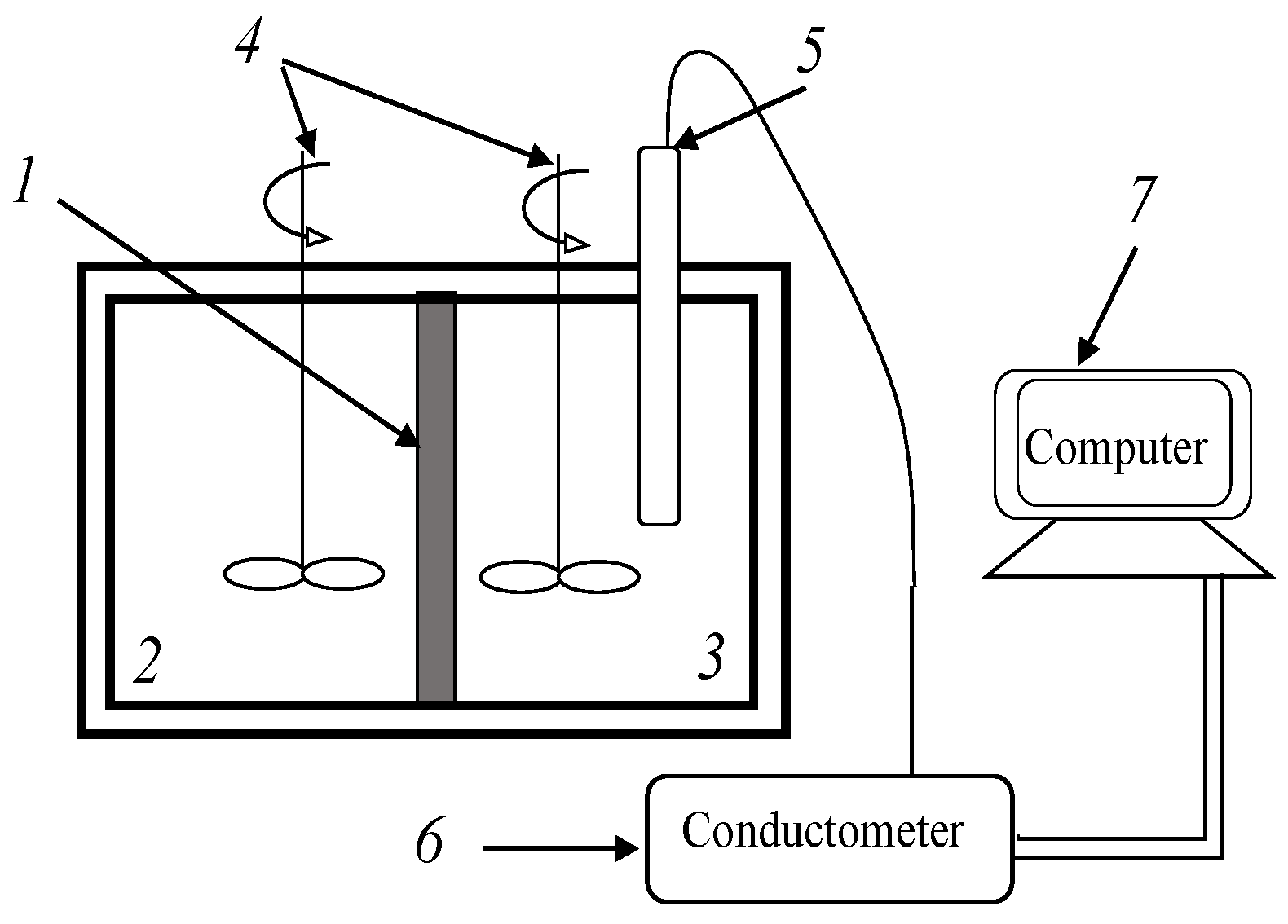
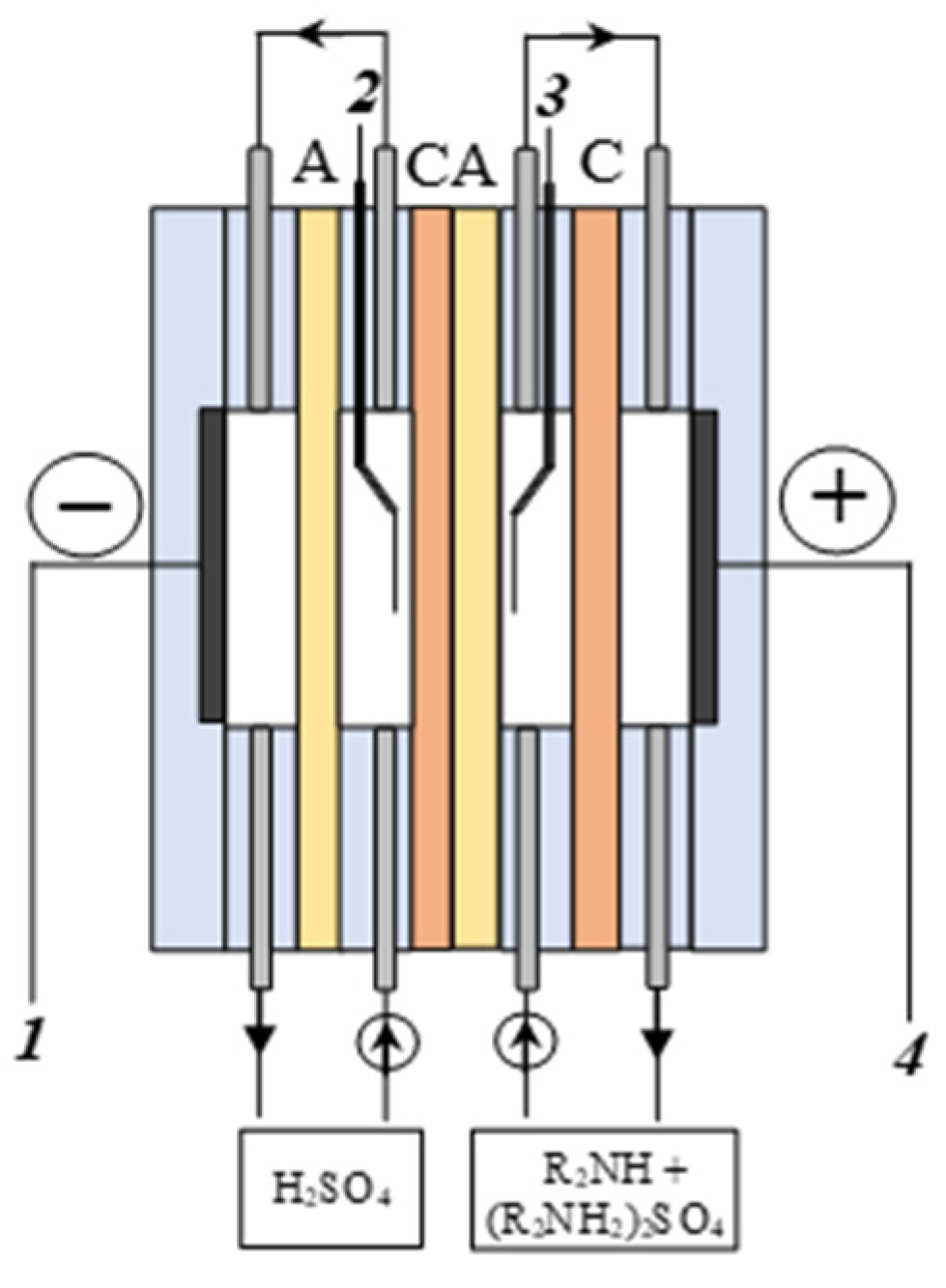
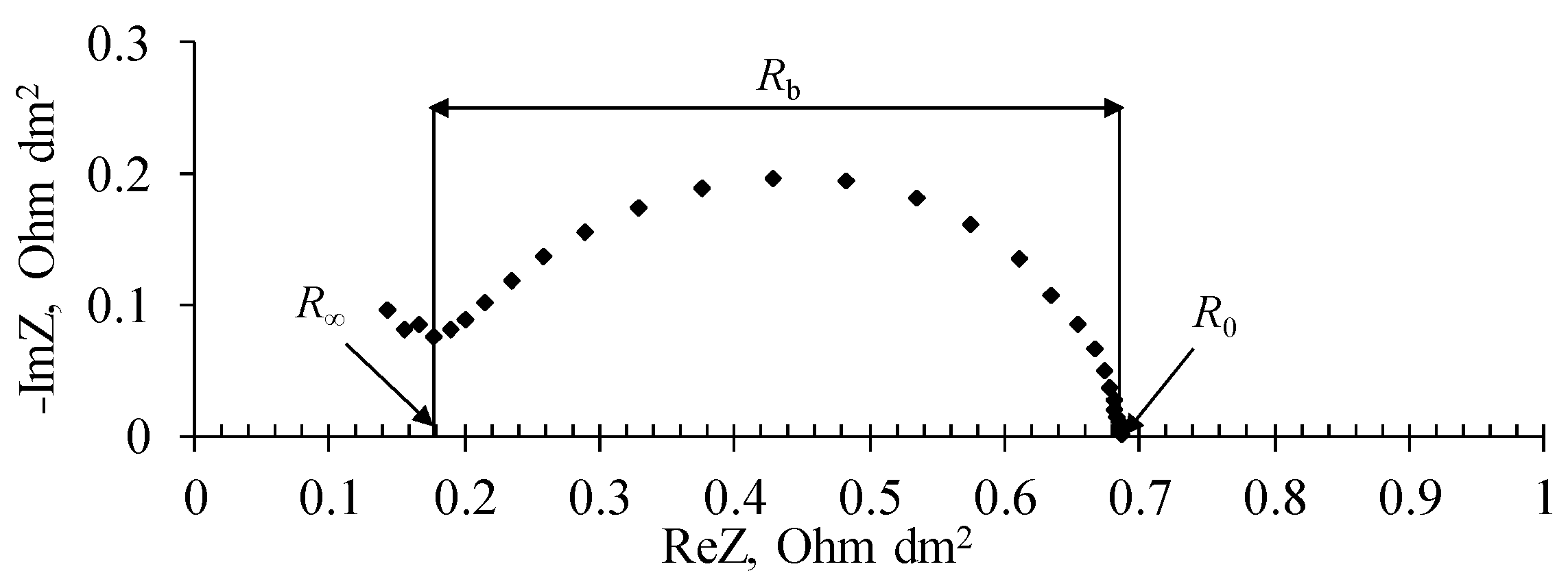
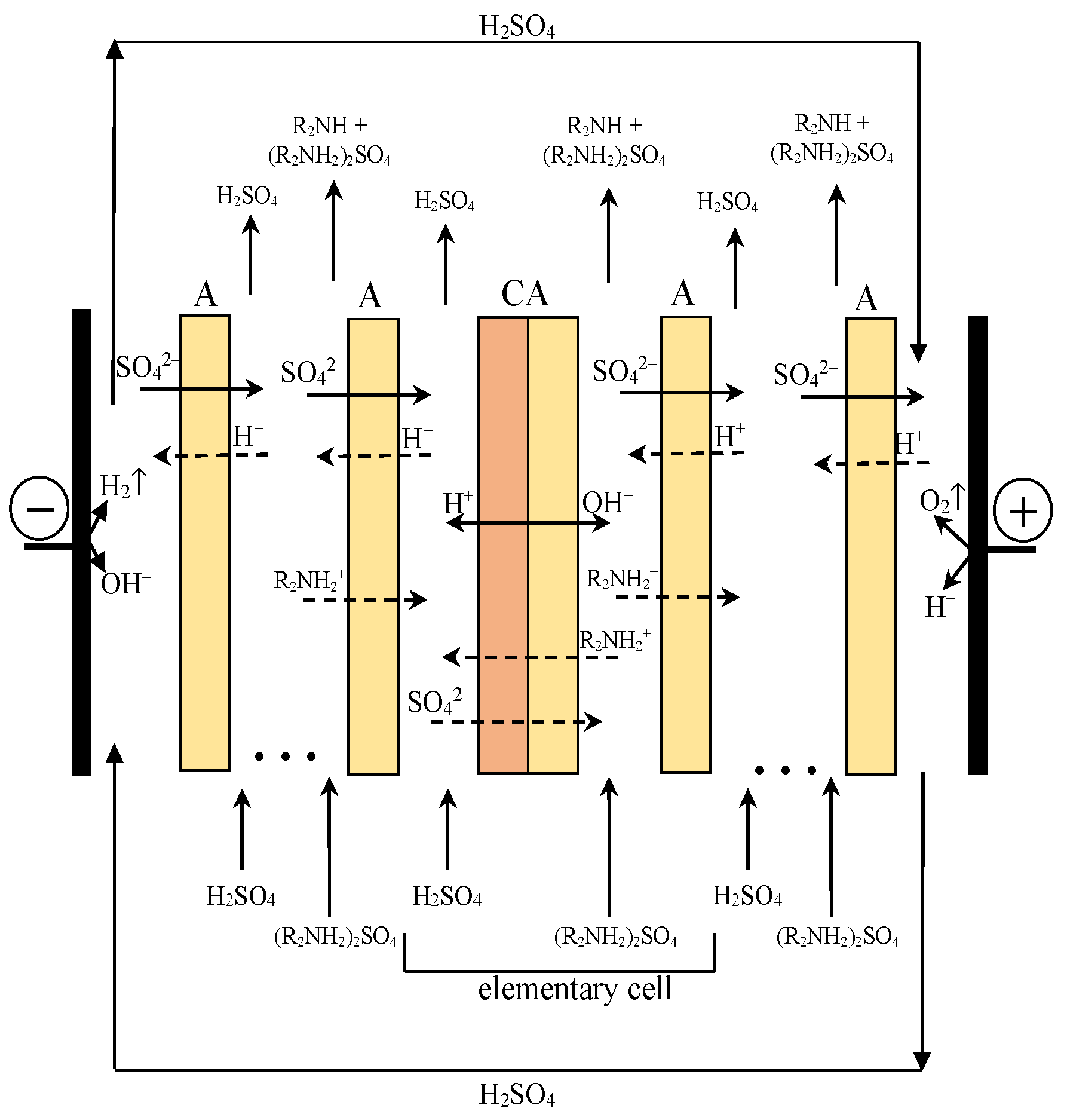
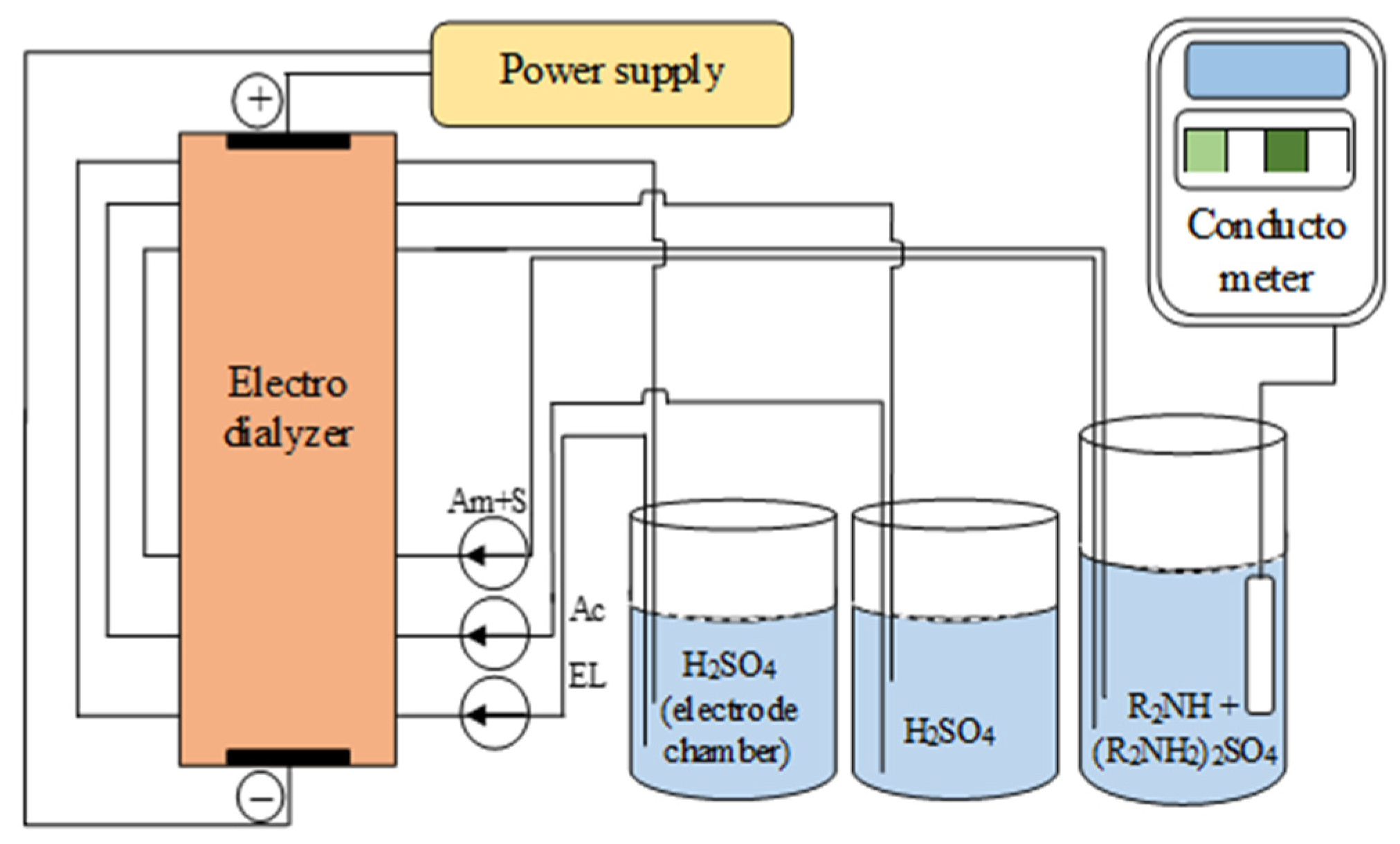
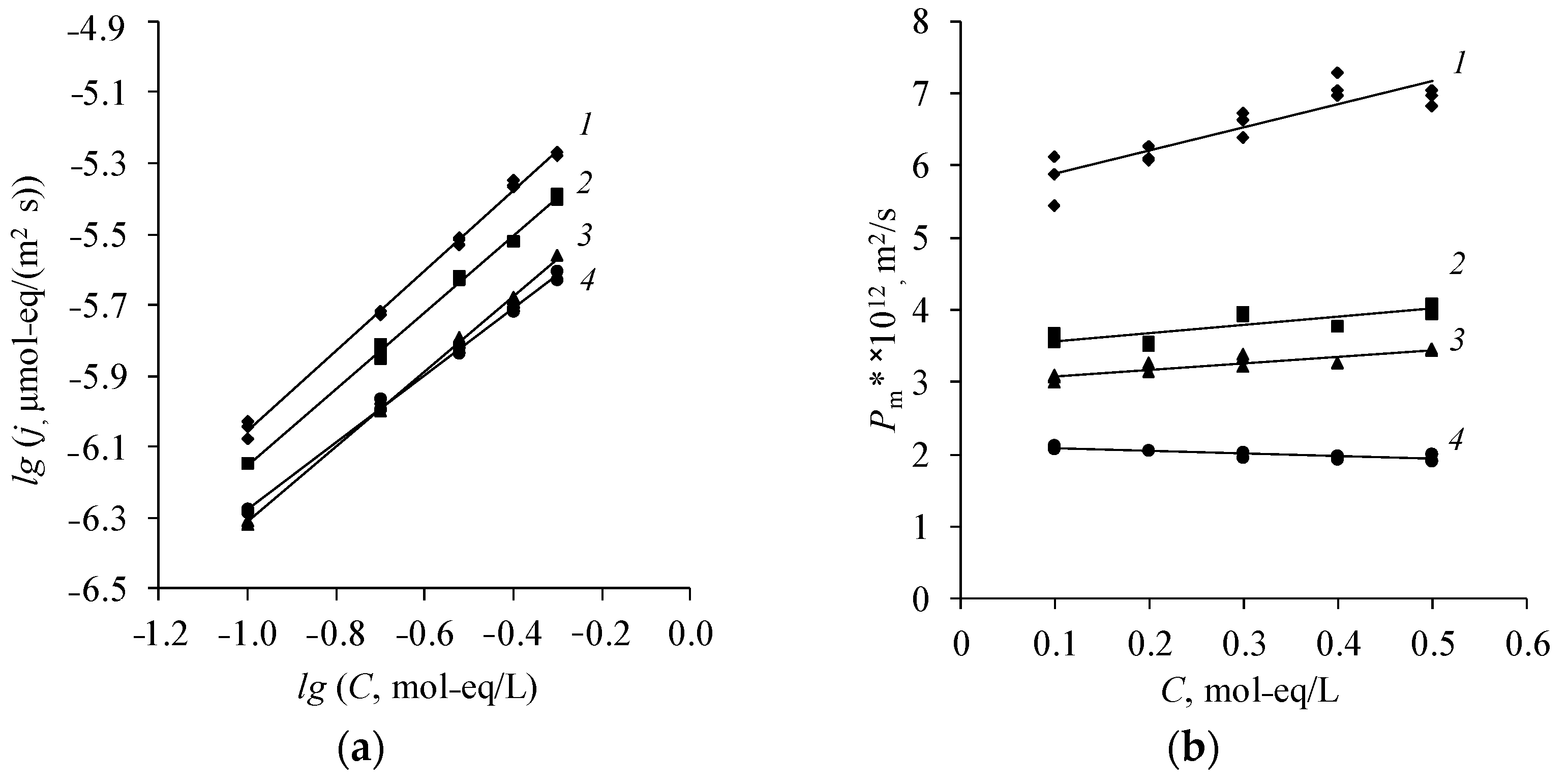


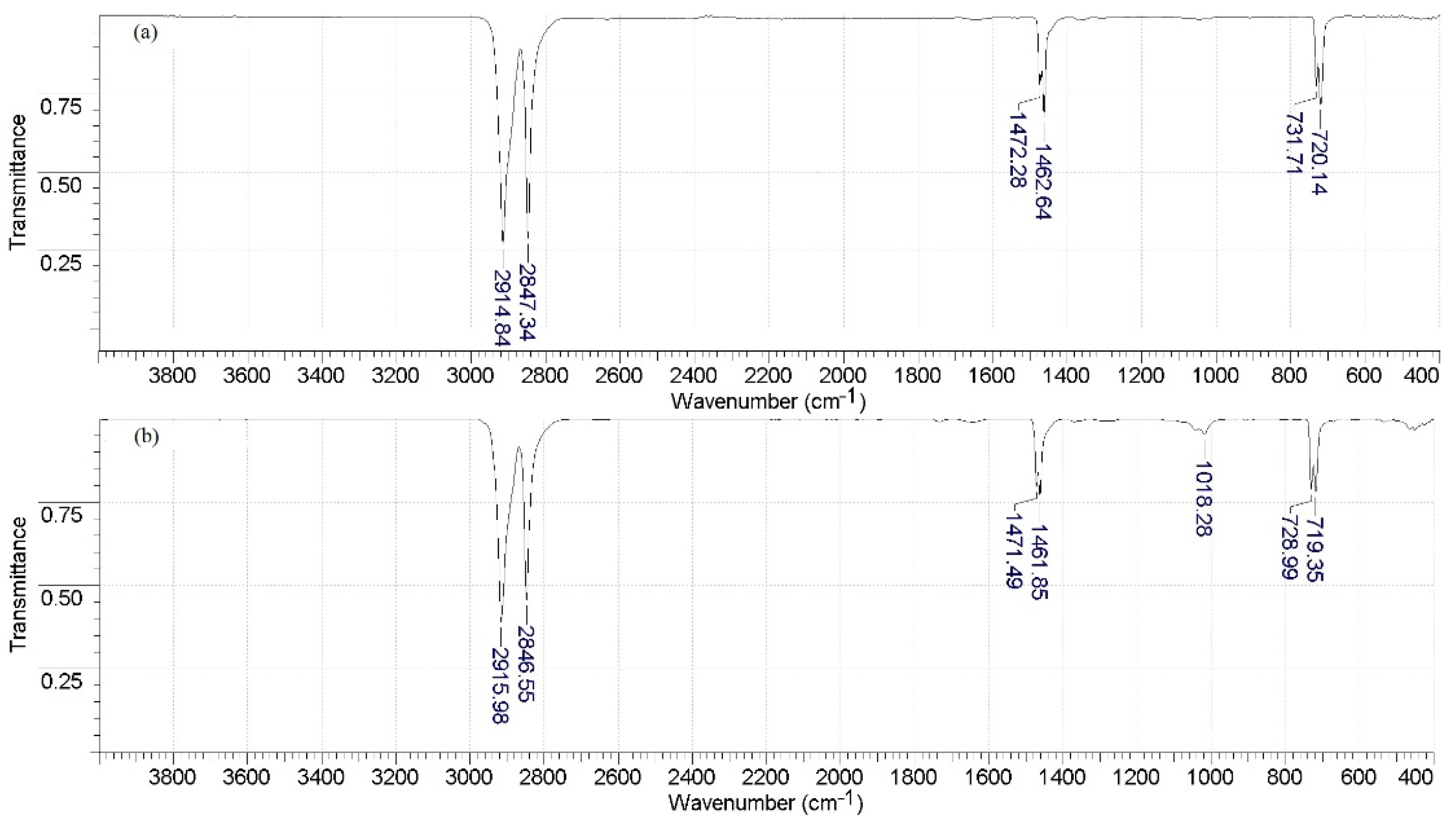




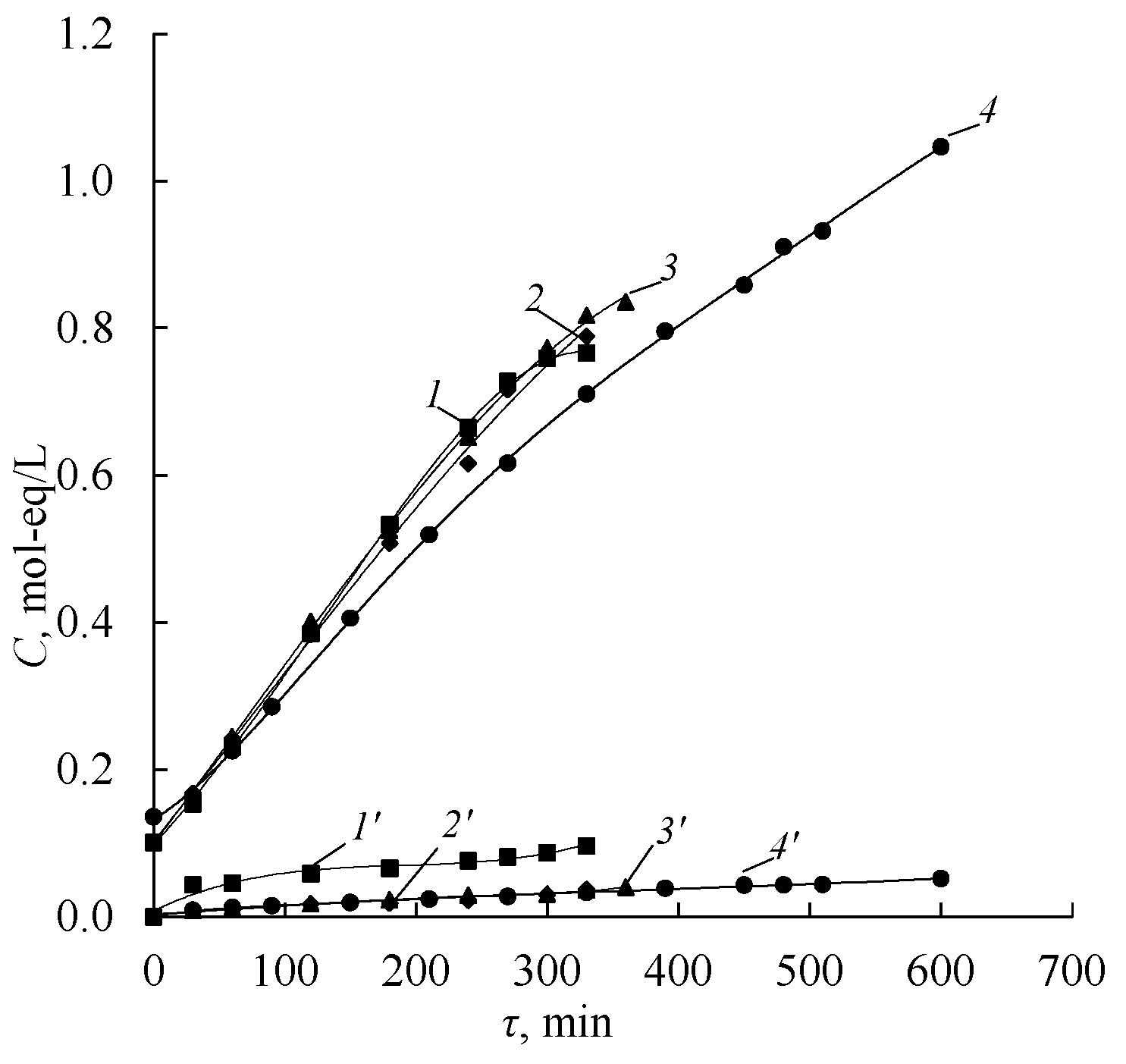
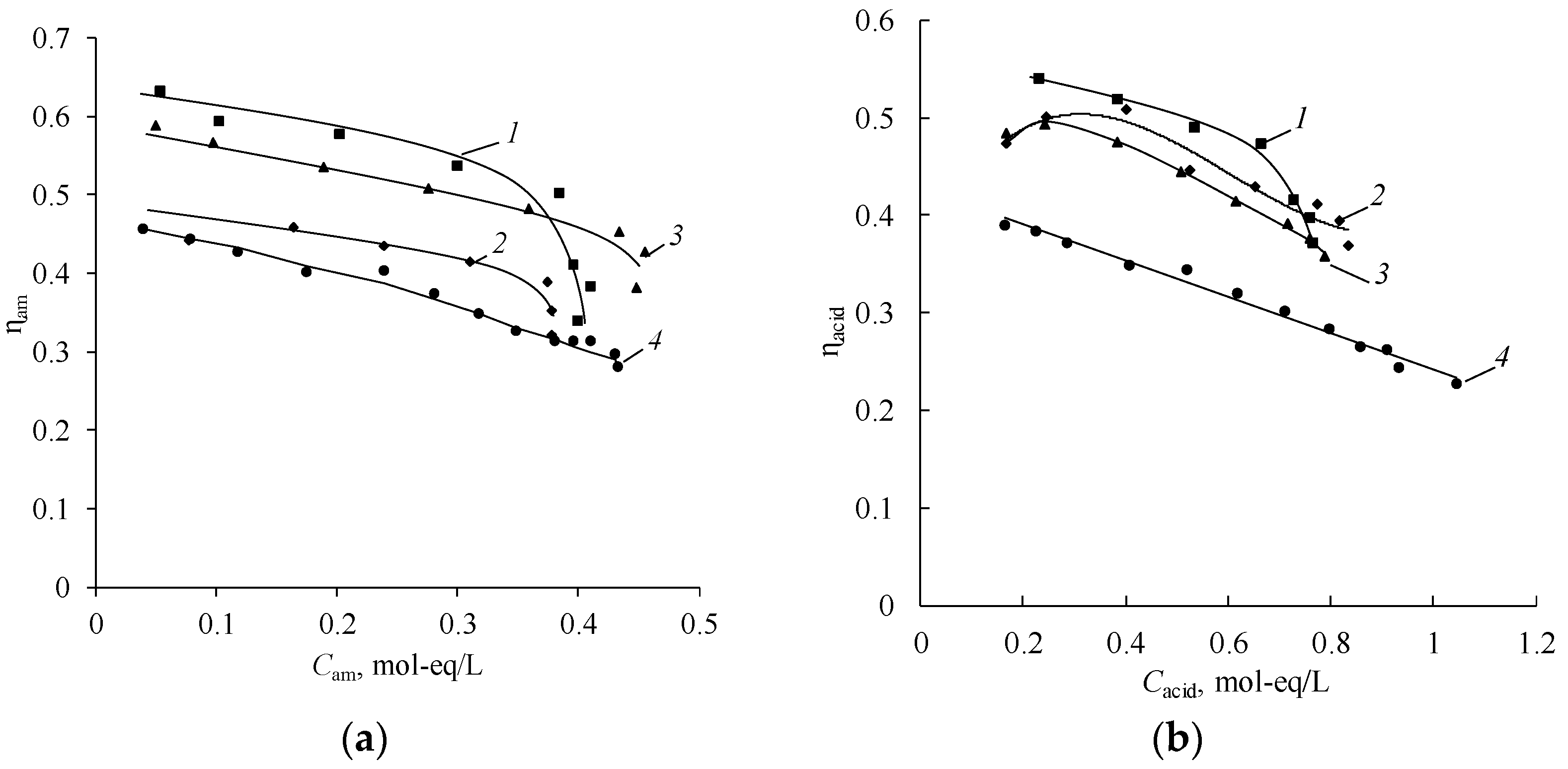

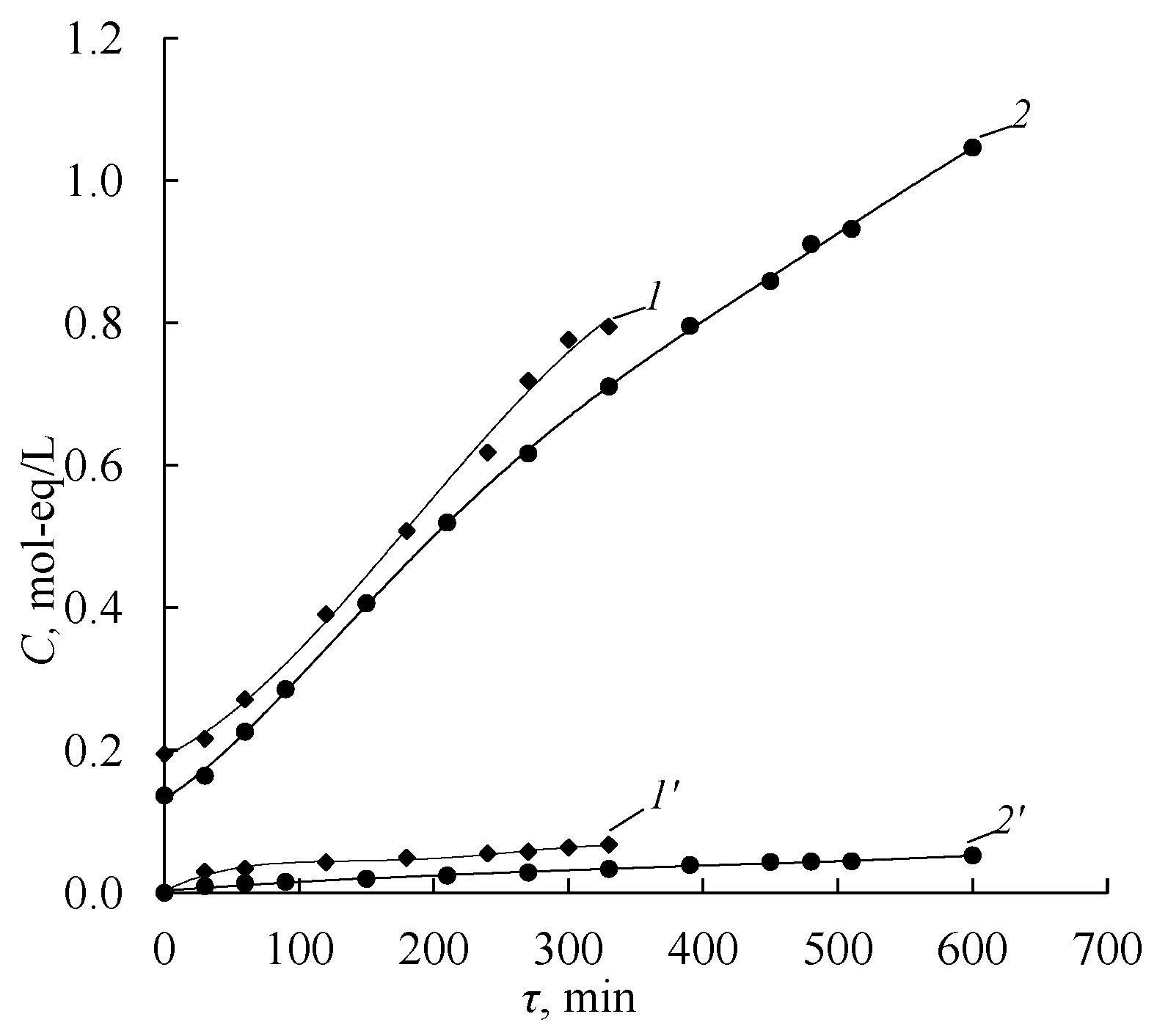
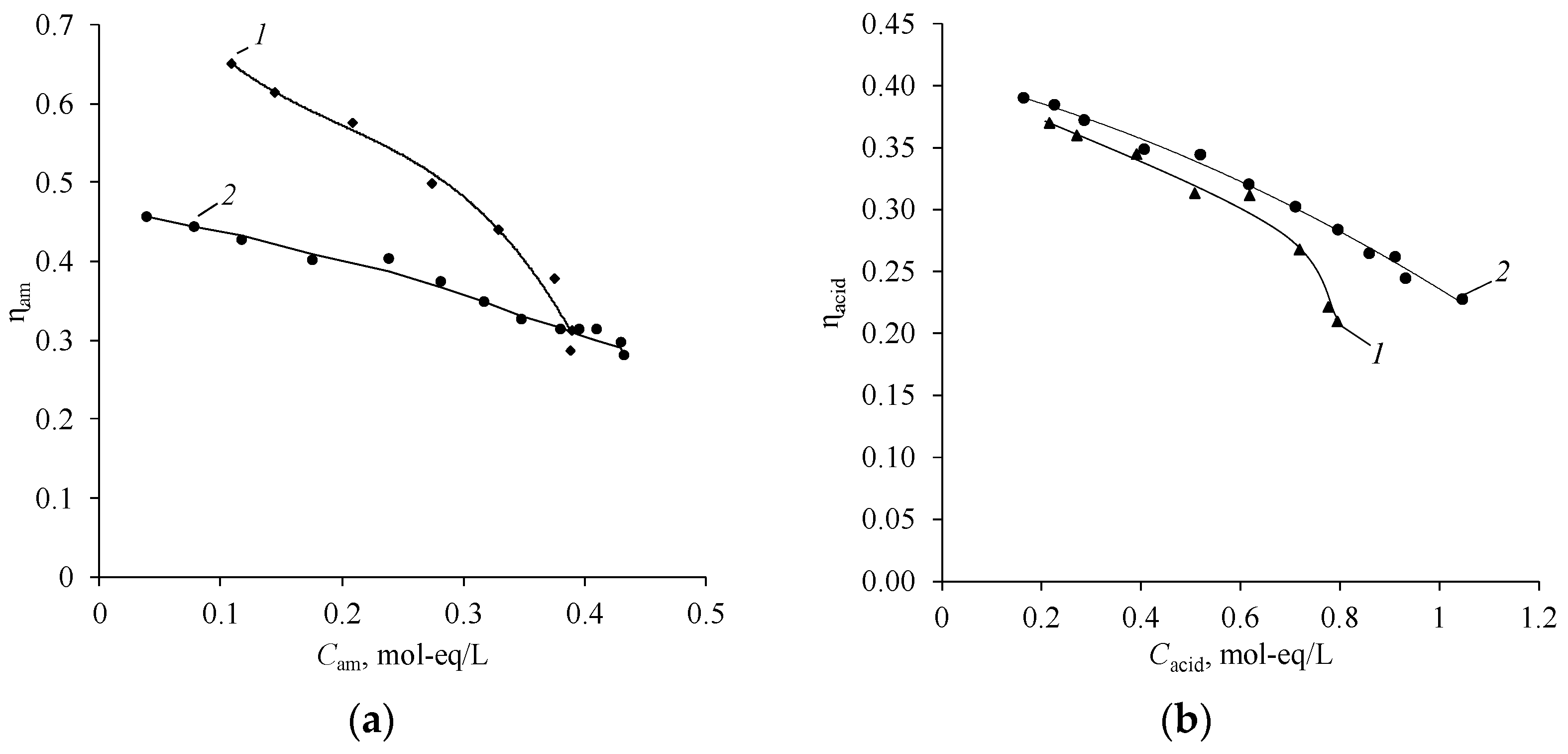
| Process Characteristics | Dimension | Source Salt (0.5 mol-eq/L) | ||||
|---|---|---|---|---|---|---|
| 1 | 2 | 3 | 4 | 5 | ||
| EDAH2SO4 | (MA)2H2SO4 | (DMA)2H2SO4 | (DEA)2H2SO4 | (DEA)2H2SO4 | ||
| Operating time of the electrodialyzer | min | 360 | 330 | 360 | 600 | 390 |
| Concentration of sulfuric acid in the acid chamber | mol-eq/L | 0.79 | 0.77 | 0.84 | 1.05 | 0.79 |
| Integral current efficiency of sulfuric acid | 0.36 | 0.37 | 0.37 | 0.23 | 0.21 | |
| Integral energy consumption in the production of sulfuric acid | kWh/ mol-eq | 0.32 | 0.20 | 0.19 | 0.45 | 1.2 |
| Integral productivity in the production of sulfuric acid | mol-eq/ (h·m2) | 2.70 | 2.84 | 2.80 | 1.75 | 1.62 |
| Amine concentration | mol-eq/L | 0.45 | 0.40 | 0.38 | 0.43 | 0.39 |
| Integral current efficiency of amine | 0.38 | 0.34 | 0.32 | 0.28 | 0.29 | |
| Integral energy consumption in the production of amine | kWh/ mol-eq | 0.29 | 0.21 | 0.22 | 0.37 | 0.87 |
| Integral productivity in the production of amine | mol-eq/ (h·m2) | 2.99 | 2.67 | 2.50 | 2.09 | 2.22 |
Publisher’s Note: MDPI stays neutral with regard to jurisdictional claims in published maps and institutional affiliations. |
© 2022 by the authors. Licensee MDPI, Basel, Switzerland. This article is an open access article distributed under the terms and conditions of the Creative Commons Attribution (CC BY) license (https://creativecommons.org/licenses/by/4.0/).
Share and Cite
Karpenko, T.; Kovalev, N.; Shramenko, V.; Sheldeshov, N. Investigation of Transport Processes through Ion-Exchange Membranes Used in the Production of Amines from Their Salts Using Bipolar Electrodialysis. Membranes 2022, 12, 1126. https://doi.org/10.3390/membranes12111126
Karpenko T, Kovalev N, Shramenko V, Sheldeshov N. Investigation of Transport Processes through Ion-Exchange Membranes Used in the Production of Amines from Their Salts Using Bipolar Electrodialysis. Membranes. 2022; 12(11):1126. https://doi.org/10.3390/membranes12111126
Chicago/Turabian StyleKarpenko, Tatyana, Nikita Kovalev, Vladislava Shramenko, and Nikolay Sheldeshov. 2022. "Investigation of Transport Processes through Ion-Exchange Membranes Used in the Production of Amines from Their Salts Using Bipolar Electrodialysis" Membranes 12, no. 11: 1126. https://doi.org/10.3390/membranes12111126




